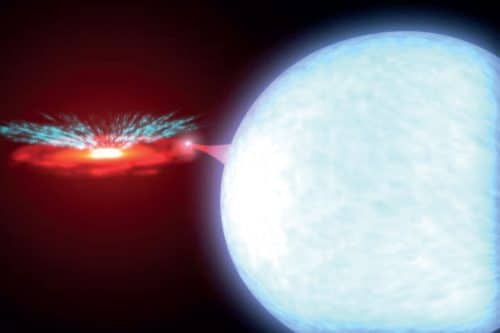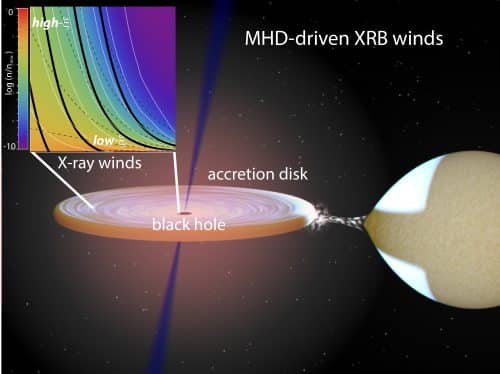Black holes - the magneto-hydrodynamic model: An international group of researchers from the Technion, the USA, Italy and Greece presents a new explanation for the emission of energy and winds from black holes.

The journal Nature Astronomy publishes a new model that explains the phenomena characteristic of the environment of black holes: radiation and plasma winds. The article is signed by researchers from Israel, the USA, Italy and Greece.
The existence of black holes as a limit of enormous gravitational force was already predicted at the end of the 18th century by the geologist John Michell and the mathematician Pierre Laplace, but only Albert Einstein's general theory of relativity allowed a real understanding of the phenomenon. At the beginning of the 20th century, physicist Carl Schwarzschild discovered the black hole solution in Einstein's equations, even though Einstein himself refused to believe in the existence of black holes in nature. Since then, there have been dramatic developments in this field, and in particular, the decisive observational evidence for the existence of black holes has multiplied.
One of the prominent characteristics of black holes is the strong winds that blow in their vicinity. The nature of the spirits and the force that drives them is explained in different ways, and in one of the theories this phenomenon is described in terms of strong and orderly magnetic fields. The present paper shows that the magnetic wind model explains not only the winds of massive black holes in the centers of galaxies but also the winds of small black holes that are very similar to stars.
In popular culture, black holes are depicted as all-devouring creatures: whatever approaches them, even if it is light, is swallowed up and never known to have come near them. While this is indeed their nature, the astrophysical truth is more complex. Black holes, it turns out, not only swallow everything in their path, but also emit radiation and plasma wind (plasma is a hot gas in which the electrons have been torn from their atoms). The plasma winds, moving at speeds between 300 km per second and more than 30,000 km per second, dramatically affect the black hole's environment and the entire galaxy.
the event horizon
Black holes are formed when a relatively heavy star (over 3.5 solar masses) collapses in on itself as a result of the loss of its nuclear fuel. At the end of the collapse, a "singularity" remains - a tiny point with a huge mass. This voracious entity feeds on the gas it attracts from neighboring stars, and since even the light it swallows cannot escape from it, it is called a "black hole".
Between the black hole and its surroundings is separated by a spherical boundary (approximately) called the "event horizon". Everything that passes the event horizon towards the center of the black hole is indeed swallowed up there forever, but around the event horizon moves, in the form of a disk, part of the "stolen gas" that was sucked from the neighboring star. This is the "adsorption disk" that emits a lot of light, mainly in the X-ray range - that's why these systems are sometimes called X-Ray Binaries - as well as a fast plasma wind and jets. This process in giant black holes in the centers of galaxies shapes the largest structures in the universe - galaxies and galaxy clusters - and produces a significant part of the ionizing radiation in the universe.
In an article now being published by Prof. Ehud Bacher from the Technion Physics Faculty, Prof. Keigo Fukumura from James Madison University (JMU) and their partners, observational evidence is presented that the magnetic field created around the black hole plays an essential role in the formation of the absorption disk and the winds it spreads. This article extends to all black holes the magneto-hydrodynamic model developed by the researchers for giant black holes. The fact that the same description fits black holes of various sizes, from a solar mass to billions of solar masses, indicates a general fundamental magnetic structure that exists in the vicinity of black holes.

The model described in the article was examined in great detail by mapping the absorption lines of the X-rays emitted by a variety of atoms present in the plasma wind. Prof. Becher, who led the spectroscopic analysis in the study, explains that "the absorption lines, which we map based on their kinetic characteristics (blue shift), provide us with extensive and in-depth information on the composition of the wind and the energy in the vicinity of the black hole. They allow us to quantitatively map the density of the wind, its ionization level, its energy and its speed. The fact that a relatively simple model of magnetic wind describes the wind in its complexity makes it a successful model."
In conclusion, the article published in Nature Astronomy sheds light on the "conduct" of black holes and especially on the mechanisms of their influence on their environment. The magneto-hydrodynamic model is extended in this article to black holes on the entire size scale - from M☉10 to M☉109 (when M☉ is the mass of the sun).
For an article in Nature Astronomy click here

One response
To the best of my knowledge, this is not a new theoretical model but mainly a new and more accurate observational confirmation of an old and well-known model that is essentially described by the adsorption disc and the magnetic fields it creates, described in the article.